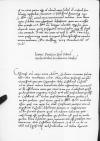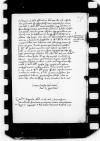List #47
Ioannes DANTISCUS do Mikołaj GRABIAHeilsberg (Lidzbark Warmiński), 1540-12-17
Regest polski:
Dantyszek pisze list nie tylko w odpowiedzi na ostatni list adresata, dostarczony przez kasztelana gdańskiego [Achacego Czemę], ale także aby podzielić się z nim zmartwieniem, którego przysporzyli mu skryci donosiciele.
Przed wyruszeniem kasztelana gdańskiego na dwór królewski dotarła do niego pogłoska, że został ponownie pomówiony przed królową [Boną], jakoby wspólnie z pewnymi członkami rady [Prus Królewskich], zwłaszcza z radą miasta Gdańska, przygotował bunt i tajny spisek. Nie wierzył, że doszło do tak niedorzecznego oskarżenia, dlatego nie poruszył tej sprawy w rozmowie z kasztelanem gdańskim ani nie uznał, że powinien przekazać przez niego coś na ten temat na dwór - ani na piśmie, ani ustnie.
Przeczytawszy poprzedniego dnia list królowej, przekonał się, że pogłoska była zgodna z prawdą. Królowa zachęcała go do wiernej służby jako senatora w taki sposób, jakby następnego dnia miał odejść albo dotąd nie wywiązywał się z obowiązków należycie. Wyciągnął stąd pewny wniosek, że oszuści ponownie wytoczyli przed królową takie samo oskarżenie jak kilka lat temu, gdy w tej sprawie Grabia przyjechał do niego do Lubawy.
Swojej niewinności broni w liście do królowej. Grabię prosi, aby wstawił się za nim u królowej, a przynajmniej dowiedział się, kim są donosiciele. Jeśli Dantyszek pozna ich nazwiska, będzie mógł dowieść swojej niewinności przed sądem królewskim, aby w przyszłości królowa nie musiała go już tyle razy upominać.
Rękopiśmienne podstawy źródłowe:
| ||||||||||
Tekst + aparat krytyczny + komentarz Zwykły tekst Tekst + komentarz Tekst + aparat krytyczny
Generose Domine, amice unice carissime.
Salutem et omnem felicitatem.
Has tumultuario ad Dominationem Vestram calamo perscripsi non solum, ut cf.
Priusquam
 BJ, 6657, f. 393r Lectis porro serenissimae
BJ, 6657, f. 393r Lectis porro serenissimae
Proinde, quantum potui, humilius et modestius serenissimae
Quam diutissime feliciter valere ex animo cupio.

